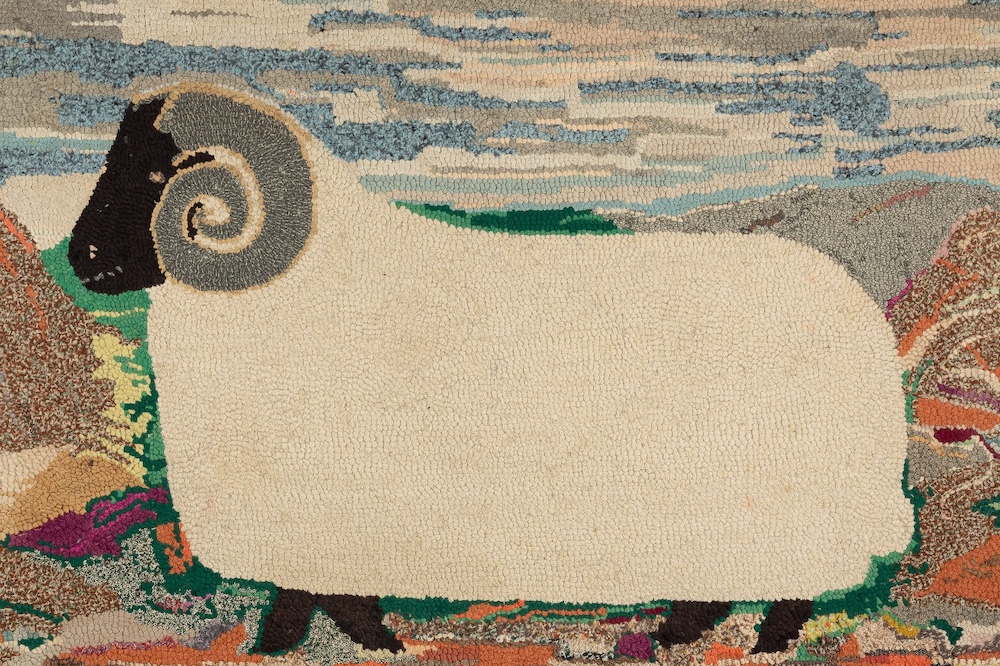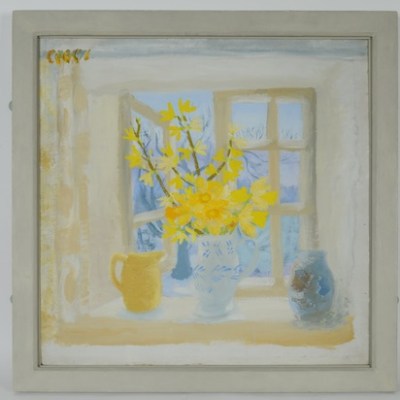In around 1937, the artist Arthur Jackson Hepworth photographed the kitchen of Bankshead, the rustic Cumbrian farmhouse that Winifred Nicholson had bought with her then-husband Ben Nicholson in 1924. On the wall is Composition with Double Line and Yellow (1932) by Piet Mondrian – Winifred is said to be the first person in Britain to buy his work. A dog sleeps on a rag rug placed in front of the fireplace. You can just about glimpse a design that includes a sheep, a chicken and a duck, arranged in a grid that distantly echoes Mondrian’s rectilinear painting – albeit in far cosier form.
Though Animal Squares (c. 1925) – designed by Ben Nicholson and made by local maker Mary Bewick – was treated just like those cheap and cheerful rugs of upcycled rags that you can find on high streets today, somehow it has survived a century to appear in ‘Winifred Nicholson: Cumbrian Rag Rugs’ at Middlesborough Institute of Modern Art (MIMA). The photo features in the accompanying book by exhibition curator Jovan Nicholson, a grandson of Ben and Winifred’s.
Installation view of ‘Winifred Nicholson: Cumbrian Rag Rugs’ at Middlesbrough Institute of Modern Art, 2024, with Lion (c. 1971), designed by Winifred Nicholson and made by an unkown maker, hanging middle right. Photo: Rachel Deakin
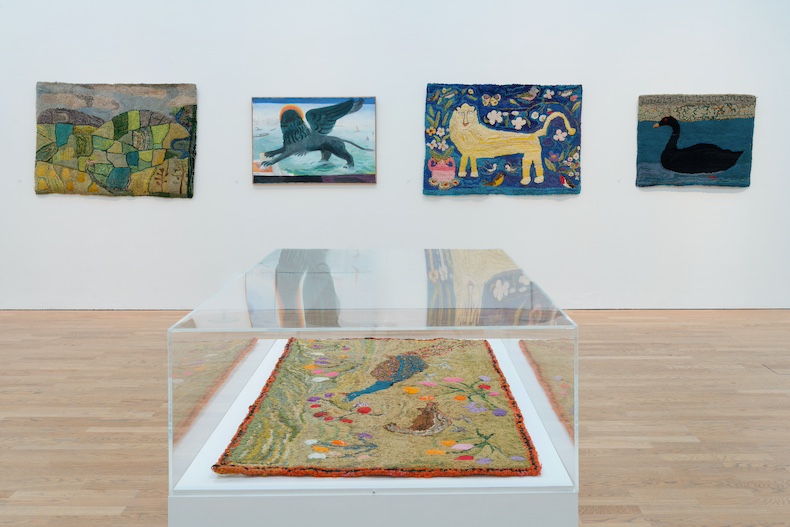
Through rugs, paintings and archival materials, the exhibition shows how the Nicholsons first encountered the traditional craft of rag rug-making through their neighbour Margaret Warwick. Encouraged by the couple’s enthusiasm, Warwick made rag rugs according to the artists’ designs as well as planning and making her own. In the 1960s, Winifred’s affection for these rugs led her to become both designer and patron on a grander scale: she commissioned at least 180 rugs from 13 local makers, 28 of which are on show here. These were given or sold to the artist’s friends and acquaintances, or sold through Primavera gallery in Cambridge.
Such rugs had been made in Britain for centuries by working-class families for their own use, though the craft became increasingly popular in the mid 19th century. Worn-out textiles were collected over the course of a year, cut into small strips, then pushed or pulled through hessian using a hooked tool. It was time-consuming stuff, traditionally treated as winter work: producing one per year was standard. The newest rug would take pride of place, with the oldest demoted to the dirtiest role.
Sheep (1960s), designed and made by Mary Bewick. Private collection
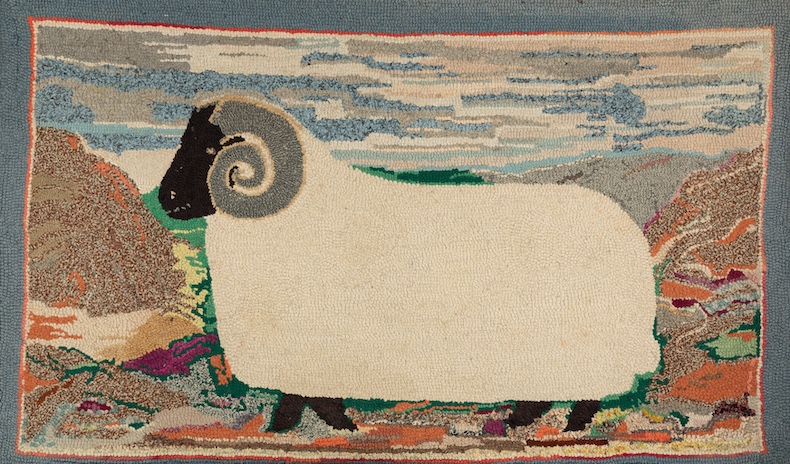
This exhibition has clearly been a labour of love. It is the first time these rugs have been shown in any number; only one had been exhibited previously. Tracking down the works on show – and simply finding enough of them in decent condition – must have been no mean feat. Jovan writes with regret of the rugs’ ‘tendency to get flooded, succumb to chip pan fires, or be savaged by moths’. Familial connection aside, it’s not hard to understand why the curator went to all this trouble. The rugs are wonderfully charming – I caught myself beaming on my first walk around the room (something I’ve never done while looking at Ben Nicholson’s paintings).
Some of the rugs recall paintings commissioned by 19th-century farm owners to show off their marvellously large and rectangular cows, pigs and sheep. Work in this category includes Galloway Bull and Sheep, both designed and made by Bewick in the 1960s. Unlike those more staid antecedents, Bewick sets her livestock in landscapes built up from swirling layers of multicoloured cloth. Up close they are psychedelic, reminiscent of textiles by the artist and medium Madge Gill. It’s a canny way of using up scraps of many different colours, while being a practical choice for a hardworking textile: much like the patterns on the London Underground’s seats, those zig-zagging layers could hide decades of grubbiness.
Occasionally, long stitches are used on top of the knobbly surfaces to pick out fine details such as facial expressions. The results are mixed: some creatures resemble the work of an amateur taxidermist; the face of the splendid Tiger (early 1960s), designed and made by Janet Heap, recalls a lugubrious Victorian patriarch, whiskers and all; while Winifred’s Lion (c. 1971; unknown maker) has shades of Charlie Chaplin.
Tiger (1960s), designed and made by Janet Heap. Private collection. Photo: © Stuart Walker Photography 2024.
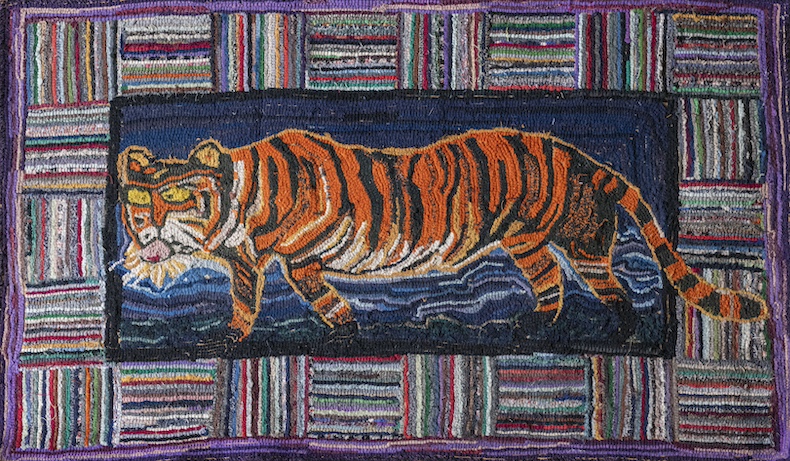
Others have a mysterious air, rather like tarot card designs, or the look of an old-timey fairground sign. These include Winifred’s beatific The Sun and the Moon (c. 1970), made by Bewick, and Four Storks (c. 1983) designed by Winifred’s friend Li Yuan-chia and made by a group of women at the nearby LYC Museum & Art Gallery, which Li founded. Some were based on drawings by Winifred’s grandchildren, whom she paid £1 for each of their efforts. There are three rugs designed by a six-year-old Jovan: cheerful, blocky renderings of tractors and farmland. His brother David’s Batman and Robin (1968) hangs beside them, with ‘POW’s and ‘ZOC’s lifted straight from the cartoons.
If there’s a criticism to be made, it’s that the rugs are so vivid, so unselfconscious, that Winifred’s paintings can appear rather limp by comparison. The exception is when she paints her neighbours. There is a warmth of feeling that shines through works showing the women Winifred employed to make rugs, such as The Warwick Family (c. 1926) and Janet and Jacob Reading (c. 1930).
Though the past decade has seen a transformation in how textile art is treated by the art world, rag rugs – unlike weavings or quilts, say – are yet to have their moment in the sun. Here’s hoping that this small yet remarkable exhibition might change their fortunes.
Batman and Robin (1968), designed by David Nicholson and made by Florence Williams. Private collection. Photo: Rachel Deakin

‘Winifred Nicholson: Cumbrian Rag Rugs’ is at the Middlesbrough Institute of Modern Art until 23 March 2025.
